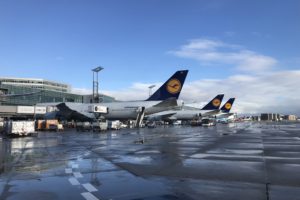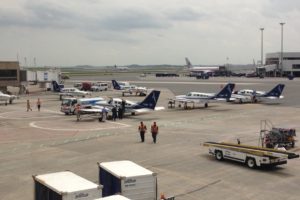Photos: Museum of Flight (Seattle)
On August 10 (yes, the day the Horizon Air Q400 was stolen, although I was in Portland by that time), I had the chance to visit the Museum of Flight in Seattle. The day before, I had gone on a factory tour of the Boeing Everett Factory at Paine Field, so check out the review here. The Museum of Flight is located at Boeing Field (which is very close to SeaTac and the Renton Factory) where Boeing’s delivery centers for 737s and military aircraft are. The airport also has a lot of general aviation going in and out of it. The Museum of Flight is located at the south end of the airport and is debatably the best aviation museum in the world (although for a DC native, I still think that the Udvar Hazy Center at Dulles is the best). Just to be clear, the Museum of Flight is not owned by Boeing.
The museum has a large array of both military and commercial aircraft. There is a southern part of the museum next to the parking lot and airport which is home to the original barn of Boeing, the store, the cafe, and an exhibit with dozens of antique commercial and military aircraft. Across a bridge over the street is a little space exhibit with a fake space shuttle miniature model (not that interesting). Next to that is the best section of the museum which features a lot of commercial and military aircraft, both historic and current in an extremely large hanger. The best part: you can enter most of the commercial aircraft and walk around in them! As you can imagine, I spent most of my time there walking around in the aircraft! One last thing, the museum is massive. We didn’t get to visit a couple of sections in our 2 + hour visit of the museum, due to the massive size of the museum!
Arrival at the Museum:
Since we were on our way out of Seattle and heading to Portland, we figured we should visit the museum since it was right on the way. Before visiting, I got some pictures of Boeing Field which is also where the final delivery center for 737s is. You also could see into the large hanger of the museum from the road, which is where I got the picture of the 787 from.

Boeing 737

787 in the Museum
We then took a left to the parking lot for the museum which sits right by the runway of Boeing Field. There were two fighter jets sitting in the parking lot, and there was a Lockheed Super Constellation sitting at the entrance to the museum.

A Couple of Fighter Jets

Trans Canada Airlines Lockheed Constellation
Eastern Wing:
We entered the museum and found a long line at the entryway. Instead of buying tickets there, we decided to buy tickets online, which proved to be marginally faster. However, we then were told to go to another place to get wrist bands which would allow us to enter exhibits at the museum. We first visited the eastern part of the museum (which was the less interesting part for me). We went to two of the three sections on the eastern side: one which had the actual original barn where people created Boeing planes, and the other which held general small historical aircraft, both commercial and military. We first headed to the red barn exhibit which was about the history of Boeing and commercial aviation. It was mostly about the beginnings of Boeing and their original aircraft and about some of the other original companies that made airplanes such as Curtiss and Lockheed. We only spent around 10 minutes there because that wasn’t the most interesting part of the museum and because we in a bit of a rush.

In The Red Barn

In The Red Barn

In The Red Barn
We headed over to the section which featured older aircraft such as the DC 3 and an SR-71 Blackbird. It showcased dozens of aircraft hung from the ceiling which almost gave the illusion that they were flying.


An Original Boeing Airplane
We first headed to a cutout section of a former US Air Boeing 737-200. The best part: it featured the first class section of the airplane. The even better part: the first class section was fully intact, and you could sit in them! I spent a good amount of time playing around with the first class seats there. What I can say is that first class seats domestically haven’t changed much over the years.

US Air 737-200 Cutout

US Air 737 First Class Seat

US Air 737 First Class Seats

The Tray Table Even Works!

US Air 737 Cockpit
We then walked around that section a bit more, while I took a few more photos.


An Alaska Airlines DC-3



A Boeing Model 80 of United Airlines

Western Wing:
After that, we headed over to the more interesting side of the museum (to me) where there was a small section about space and a hanger with many historical aircraft which you could actually walk around in! We first had to cross a bridge over the road to get to the entrance of the space part of the museum (which you have to go through to get to the hanger.

Walkway to the other side.

Space Gallery
The Space Gallery section was actually pretty small. The big feature of it was a mock space shuttle which was not as big as the real ones and didn’t have wings, engines, or wheels. For someone who has seen the Space Shuttles Enterprise and Discovery at the Udvar Hazy Center, the space shuttle thingy was pretty useless. They even offered a tour of the “cockpit” for a lot of money (relatively). Definitely not doing that. You could go into a fake docking bay in the space shuttle, which was pretty uninteresting. They did have a few exhibits such as a Soyuz capsule, which only took a couple of minutes to see.

Inside the “Space Shuttle”

Soyuz Capsule
Now for the part that I had been waiting for the entire day: the actual section with real commercial airplanes that you can walk through! Past the Space Section was the big hanger with airplanes such as Air Force One (the 707 version), a Concorde, a 727, the first 747 to be built, one of the first 787s, and a couple fighters and bombers. We first checked out the Concorde of British Airways which was right to the left of the entrance to the hanger. We were able to go inside and see the interior of it, though unfortunately the seats were blocked off so we couldn’t sit in them.

Seating

The Nose of the Concorde

Restrooms

Concorde Interior

The Air Force One from the Nixon Era Seen From the Concorde

British Airways Concorde

British Airways Concorde

Concorde Cockpit
We then headed over to the Air Force One from the Nixon era after seeing some more antique smaller commercial and military planes. It was a modified Boeing 707 also called a VC-137.

DC-3 of TWA

B-29

Boeing 247

Inside the old Air Force One

Inside the old Air Force One

Inside the old Air Force One

Inside the old Air Force One

Inside the old Air Force One

Inside the old Air Force One

Inside the old Air Force One

United 727
We then walked to one of the first Boeing 787s ever built where we could also walk inside. It showcased Rockwell Collins (the BE Aerospace) Parallel Diamond seats, which are the same seats found on United’s 787s and 767s. Unfortunately, we weren’t able to test out those seats. There was a large section of economy without any seats, presumably because they didn’t want to spend extra money for a plane full of seats that will never be used.

Business Class

Business Class

787 Cockpit

Economy Class

787

A NASA 737 Seen From the 787
We now headed to the first 747 (named City of Everett) ever built which was also at the museum! Fortunately, you can enter it. Unfortunately, it was not really configured with any seats as it never flew for an airline. Even more unfortunate: you couldn’t even go up the spiral staircase into the upper deck. 😥 Instead, the aircraft was full of signs displaying the history of that aircraft and the 747. Did you know that the first 747 was actually configured to be an areal refueler?

The Rear

The Few Passenger Seats on the Plane

Flight Instruments

Spiral Staircase

The Nose of the 747

City of Everett Boeing 747-100

City of Everett Boeing 747-100
Lastly, we went into a former Boeing 727-100 that used to belong to United Airlines which still has the old United interior. It’s fun to see how much economy and business class on United has changed over the years. By changed, I mean that the seats have gotten much, much, much thinner with a lot less legroom.

First Class

First Class

Economy Class

Economy Class

United 727-100
After that, it was time to go back over the bridge to the other half of the museum and back to the parking lot. On the bridge, I managed to take a picture of the Boeing original barn which I had visited earlier.

Boeing Original Red Barn
Conclusion:
The Museum of Flight at Boeing Field in Seattle offers a massive array of historical commercial and military aircraft on display. While the eastern sections which I visited first were just average (in my opinion), and the space section was pretty uninteresting, what made me love the museum the most was the hanger with all of the commercial aircraft. What made that really special was that you were actually able to enter the airplanes, which is something that can’t be done, even at the Air and Space Museum in DC. Overall I really enjoyed the museum. I mean, what aviation enthusiast can’t enjoy spending a couple hours among historical aircraft? Overall, as I said about the Everett Factory Tour, if you are living in or visiting Seattle and you are somewhat interested in aviation, I do recommend visiting the Museum of Flight, the second best aviation museum I have been to (behind the National Air and Space Museum).




